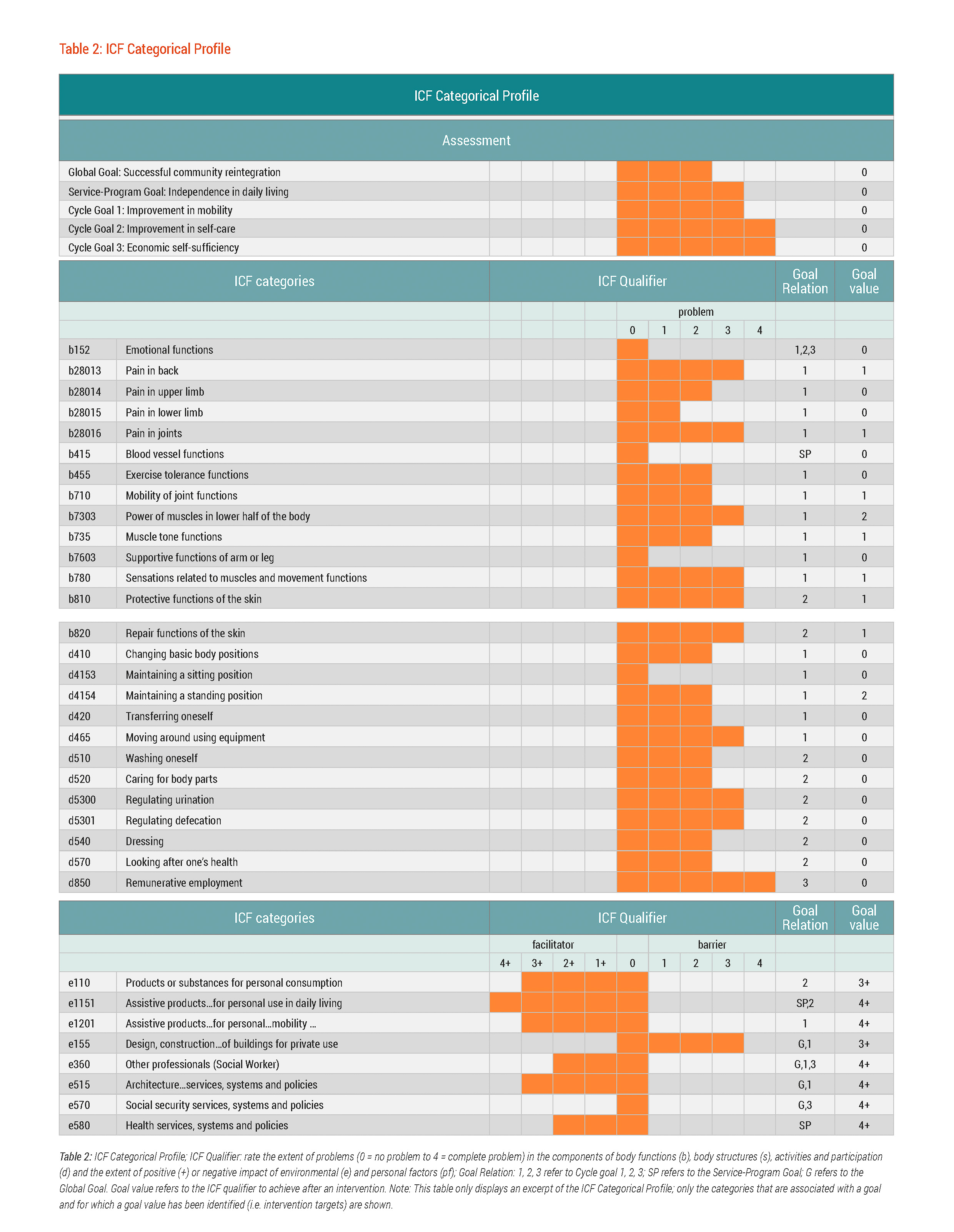Goal-setting/Determination of Intervention Targets

Mutual Rehabilitation Goals
Based on the results of the comprehensive assessment, Conrad and the rehabilitation team identified short and long-term goals. Within the framework of the Rehab-Cycle® short-term goals are called “cycle goals”. In Conrad's case, three cycle were set: improvement in mobility, improvement in self-care, and economic self-sufficiency. Achieving these cycle goals were the “stepping stones ” toward achieving the service-program goal set by Conrad and the rehabilitation team i.e. independence in daily living. The service-program goal is the goal that is expected to be achieved at the end of this particular Rehab-Cycle®. The broadest of the goals set was ‘successful community reintegration’; this long-term global goal is what Conrad and the rehabilitation ultimately wanted to achieve, a goal that went beyond this Rehab-Cycle® and rehabilitation in general.
Conrad's cycle goals, service-program goal, and the global goal were documented using the ICF Categorical Profile. The ICF Categorical Profile created for Conrad not only showed his goals, but also a visual depiction of the comprehensive assessment results as categories of the International Classification of Functioning, Disability and Health (ICF) and a bar chart that reflected Conrad's status in these categories at time of the initial assessment using ICF qualifiers. See table 2.

Table 2. ICF Categorical Profile; ICF Qualifier: rate the extent of problems (0 = no problem to 4 = complete problem) in the components of body functions (b), body structures (s), activities and participation (d) and the extent of positive (+) or negative impact of environmental (e) and personal factors (pf); Goal Relation: 1,2,3 refer to Cycle goal 1,2, 3; SP refers to Service-Program Goal; G refers to Global Goal. Goal value refers to the ICF qualifier to achieve after an intervention. Note: This table only displays an excerpt of the ICF Categorical Profile; only the categories that are associated with a goal and for which a goal value has been identified (i.e. intervention targets) are shown.
Specific Targets to Address with Interventions
The ICF categories (and personal factors) that corresponded to any of the goals set and were associated with a goal value were considered intervention targets. The intervention targets were those categories intended to be addressed with specific interventions. For example, for Conrad's cycle goal 1 ‘improvement in mobility’, Conrad and the rehabilitation team defined d465 Moving around using equipment as an intervention target with a goal value of ‘0’. This would be a major improvement in moving around using equipment from severe to no difficulty after providing one or more interventions. This meant that Conrad was expected to have no more problems manoeuvring his wheelchair nor using any other devices that facilitated mobility at the end of the Rehab-Cycle®.
""Mobility, especially mobility in the community, is one aspect of functioning that was highlighted during the initial assessment as especially problematic.""
Mobility, especially mobility in the community, is one aspect of functioning that was highlighted during the initial assessment as especially problematic. Conrad's mobility in the community was not only impacted by body function impairments, such as b710 Mobility of joint functions, or difficulty in manoeuvring his wheelchair, but also by the lack of accessibility of his home. Thus, Conrad and the rehabilitation team also identified e155 Design, construction and building products and technology of buildings for private use and e515 Architecture and construction services, systems and policies as intervention targets. To assist with clarifying the accessibility issues, including the financing for possible architectural modifications to Conrad's home, the social service support provided by the social worker (indicated by the intervention target e360 Other professionals) was essential.
The social worker was one of several members of Conrad's rehabilitation team that included a physician, a nurse, sports therapist, physical therapist, and occupational therapist.